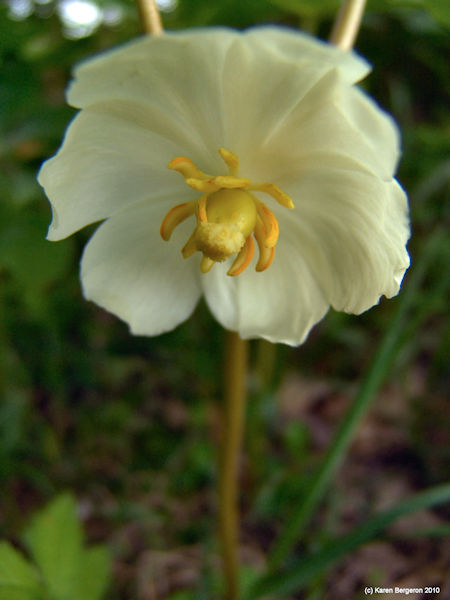May Apple, American Mandrake
Updated 03/27/2021
Podophyllum peltatum
The whole May Apple plant, apart from the ripe fruit, is toxic. The herb produces nausea and vomiting, and even inflammation of the stomach and intestines, which has been known to prove fatal. In moderate doses, it is a drastic purgative with some cholagogue action. Do not use while pregnant, nursing or trying to conceive. May Apple is not safe for use as a medicinal herb.

May Apple Uses
American Mandrake, or May Apple, is being tested as a
possible treatment for cancer
as it contains podophyllotoxin, which has an
antimiotic effect (it interferes with cell
division and can thus prevent the growth of
cells).
More Info
Mayapple is plentiful in some areas but United Plant Savers lists it on their at risk species and it is endangered in Florida. There is a small market for it if you can find a buyer and want to do a lot of digging. As it can grow aggressively and form large colonies, you may find yourself wanting to erradicate some if it anyway.
In spite of the above cautions, May Apple root has been used as a medicinal
herb in the past as a laxative and a purgative. Which means like Pokeweed, when overused you can expect to empty fluids from all orifices in a most unpleasant way. If you live through it as most do, you'll never want to do it again.
The resin of May Apple, which is obtained from the root, has been used in the treatment of warts. You can use Dandelion sap for that instead. See the link at the end of the article about topical use of May Apple root.
May Apple properties include: antibilious, cathartic, cytostatic, hydrogogue and purgative.
May Apple root and plant contain the constituents Quercetin, Kaempferol, Podophyllin, Isorhamnetin, Gallic-acid, Berberine, Alpha-peltatin, that are being studied for their healing, anticancer and other properties.

May Apple Edible Uses
The fully ripe fruit is eaten raw, cooked or made into jams, jellies, marmalades, and pies. It is very aromatic, and has a sweet peculiar but agreeable flavor. May Apple seeds and rind are not edible, and are said to be poisonous.
May Apple is also known by these names: Mayapple, Devil’s Apple, Hog-apple, Indian Apple, American Mandrake, American May Apple, Racoonberry, Wild Lemon
May Apple Description and Habitat
May Apple is a perennial native herb found growing in moist soils in rich woods, thickets and pastures in Eastern North America from Southern Maine to Florida, west to Texas and Minnesota.
May Apple grows to about 18 inches high. The stem separates into two large, dark green, long stemmed, palmate, lobed, leaves.They look almost like umbrellas to protect the large white flower which grows on a short peduncle-between the leaves.
May apple flowers bloom in April and May. The flowers turn into crab apple size edible fruits which can be gathered in early summer when fully ripe.
May Apple roots are dark brown, fibrous and jointed, gather roots after foliage dies back, dry for later herb use.
How to Grow May Apple
May apple is easy using to grow using seedling transplants or seed sown in fall. Prefers rich well drained soil and partial to deep shade.
May Apple Folklore
May Apple was once called the witches umbrella and thought to be employed by them as a poison, which may not be untrue!
The English version of this plant has much lore told of it, being called Manroot (mandrake) believed to be alive and its screams when pulled from the ground would render a man permanently insane.
May Apple Recipe
Jelly or sweet relish: Peel and deseed the ripe fruit and use your favorite jelly making skills with it. Also good fresh, but use in moderation.All parts except the fruit are TOXIC!
Article by Deb Jackson 2000 Edited and Updated by Karen
Bergeron Copyright 1999 - 2021.
Photos copyright Karen Bergeron and Altnature Herbals. Last update: 03/28/2001
May Apple References and Links
Detailed
Information about Growing May Apple
with
more herbs and flowers
Drugs.com - Mayapple. Extensive information on medical use and effectiveness.
Historic Use of American Mandrake - Mildred Grieves A Modern Herbal is online at Botanical.com
Illinois Wildflowers - May Apple
Podophyllum Topical Use - Mayo Clinic



